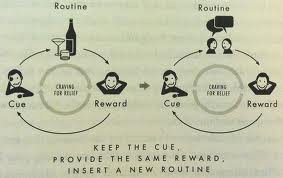Habit Reversal Training - How to Change Habits
PART 1 : THIS IS PART 2 OF A 3 PART SERIES ON HABITS : PART 3
Last week I began talking about how habits work and how, by increasing our awareness of the simple pattern that all habits seem to follow we can choose to replace bad habits or install good ones. The ideas that I am discussing are from a new book by Charles Duhigg called “The Power of Habits.” I Introduced the cycle of cue – routine – reward that Duhigg describes and gave you a brief overview of how to identify and bring more awareness to the cues that precede the behavior or habit you wish to change.
Once you have identified and tracked the cues that send you into autopilot you can now choose to follow that cue with a healthier, more supportive behavior. Consider the woman I mentioned who bites her nails. When she gets bored and feels a tingling in her fingertips her old behavior was to start rubbing her finger tips feeling for bumps or edges. When she found one she would chew on it and then, on autopilot, proceed to chew every nail on her hand until here nails were completely smooth (or completely removed). Once she had smoothed out the skin and nails on every finger she felt a sense of completeness, her reward (more about this later).
Step two of reprogramming her habit after identifying and tracking her cues was to install a new program. Whenever she became aware of the cue, of boredom leading to a tingling sensation in her fingertips, she was to do something which physically stimulated her fingertips such as rub them on her arm or wrap them on a hard surface. She practiced this routine with her therapist for 30 minutes and was then sent home with another index card. This time she made a check when she felt the cue and a hashmark when she successfully engaged the new physical stimulation. A week later, after biting her nails only 3 times instead of the usual 18 she rewarded herself with a manicure. This felt satisfying and rewarding in much the same way that completing a round of nail biting did.
Did you catch that? The key is not avoidance. When I say “don't think of a purple elephant” what are you doing? You are thinking of a purple elephant. When I say “don't bite your nails” what are you thinking about? Biting your nails. This can actually increase the compulsion and anxiety. If I help you to recognize the trigger that leads to biting your nails and then offer you an alternate behavior suddenly you have options. You have a new coping mechanism and instead of simply trying to shortcircuit the cycle you are completing it in an alternate way.
A similar routine replacement is described for other patterns. A man who snacks when he is bored at work recognizes that the rewards of going to the cafeteria include a break from his desk and some social engagement. He chooses the routine of walking over to a co-workers desk and talking to them instead. New habit installed, same rewards felt. One of the reasons that AA meetings work so well is likely that the habit of drinking is replaced with a habit of meetings (90 meetings in 90 days). The cues such as anxiety remain the same, but the coping mechanism or habit is replaced and the reward can be surprisingly similar. The social engagement, sharing of stories and camaraderie of a meeting are often shockingly similar to those at a bar, party or other social drinking event.
A cue must be identified, a new routine chosen and a reward given for following it. Sound too simple? Too good to be true? This simple process is called Habit Reversal Training. Duhigg quotes one of the developers of this process, Nathan Azrin, “It seems ridiculously simple, but once you're aware of how your habit works, once you recognize the cues and rewards, you're halfway to changing it. It seems like it should be more complex. The truth is the brain can be reprogrammed. You just have to be deliberate about it.”Let's be clear. This tool is massively powerful. A simple awareness of it and dedication to following it has helped many and can be a positive tool for anyone. But it will not always be enough. Each habit is complex and unique. And there is another factor which plays a huge role in both whether or not we can succeed at changing a habit and in whether or not the habits that we do change last. This factor is belief.
Next week we take a look at the role that belief plays in changing habits. Belief is the key to understanding how to succeed in creating the habits we do want, changing the habits we do not want and why some new habits fail completely at critical moments.
PART 1 : THIS IS PART 2 OF A 3 PART SERIES ON HABITS : PART 3


